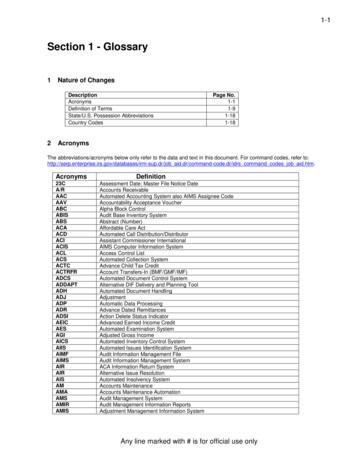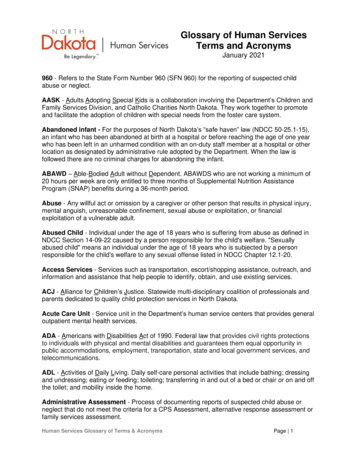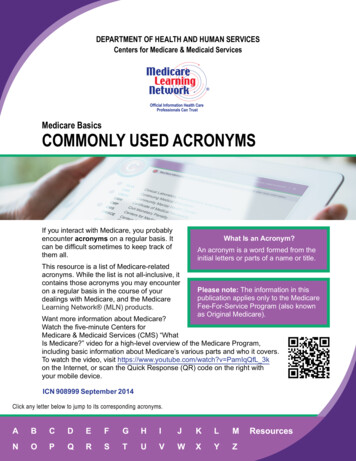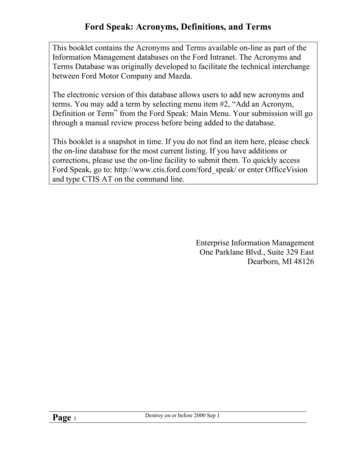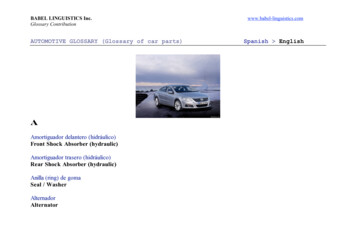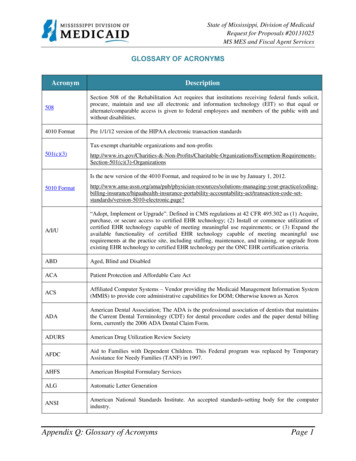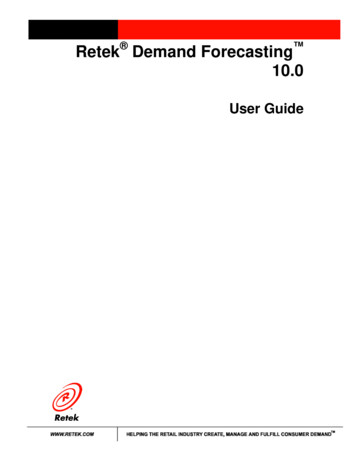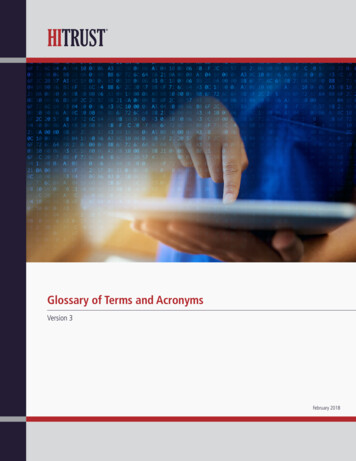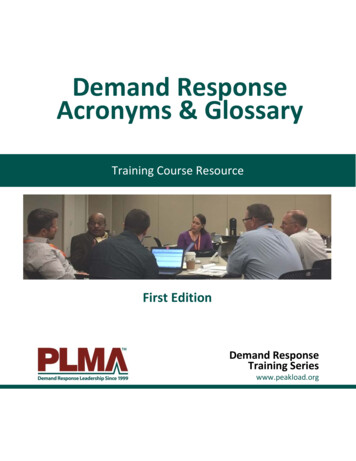
Transcription
Demand ResponseAcronyms & GlossaryTraining Course ResourceFirst EditionDemand ResponseTraining Serieswww.peakload.org
Publisher InformationDemand Response Program Design and Implementation1st Edition (May 2017)Copyright 2017 by Peak Load Management AllianceAll rights reserved. No part of this book may be reprinted or transmitted in any form or by any means,electronic or mechanical, including photocopying, recording or by any information storage or retrievalsystem, without prior written permission of the copyright owner and publisher.ISBN: Printed and bound in the United States of AmericaTrademarked names may be used in this book. Rather than use a trademark symbol with everyoccurrence of a trademarked name, we use the names only in editorial fashion and to the benefit of thetrademark owner with no intention of infringement of the trademark.The information in this book is distributed on an “as is” basis, without warranty. Although everyprecaution has been taken in the preparation of this work, neither the authors nor the publisher shallhave any liability to any person or entity with respect to any loss or damage caused or alleged to becaused either directly or indirectly by the information contained herein.CreditsThis content was initially developed with assistance from the PLMA Training e.comwww.navigant.comAcknowledgementsPLMA would like to recognize its Executive Director, the Officers and Executive Committee, and theEducation Planning Group for oversight and editorial review of the Demand Response Training Series.
PLMA Demand Response Training SeriesAcronyms and GlossaryTable of ContentsAcronym List . 1Glossary . 5Additional Resources . 14
PLMA Demand Response Training SeriesAcronyms and GlossaryAcronym ListAcronymTermADRAutomated Demand ResponseAESOAlberta Electricity System OperatorAGCAutomatic Generation ControlAMIAdvanced Metering InfrastructureARCAggregation of Retail CustomersBABalancing AuthorityBASBuilding Automation SystemBEMSBuilding Energy Management SystemBPABonneville Power AdministrationBRABase Residual AuctionBYOT / BYODBring‐Your‐Own Thermostat/DeviceC&ICommercial & IndustrialCAISOCalifornia Independent System OperatorCBLCustomer Baseline LoadC‐ECost‐EffectivenessCIMCommon Information ModelCONECost‐of‐New‐EntryCPPCritical Peak PricingCRContingency ReserveCSPCurtailment Services ProviderDADay‐AheadDDEDesignated Dispatch EntityDERDistributed Energy ResourceDGDistributed GenerationDLCDirect Load ControlDRDemand ResponseDRMSDemand Response Management SystemDRPDemand Response ProviderDRRDemand Response ResourceDSMDemand Side ManagementEDCElectric Distribution CompanyEDREmergency Demand ResponseEEEnergy EfficiencyEFORdEquivalent Forced Outage rate1
PLMA Demand Response Training SeriesAcronyms and GlossaryEISAEnergy Independence and Security ActeLRSLoad Response SystemEM&VEvaluation, Measurement, and VerificationEMCSEnergy Management Control SystemEMSEnergy Management SystemEPAEnvironmental Protection AgencyERCOTElectricity Reliability Council of TexasESCOEnergy Service CompanyEVElectric VehicleFCAForward Capacity AuctionFCMForward Capacity MarketFCM SOIForward Capacity Market Show Of InterestFERCFederal Energy Regulatory CommissionFSLFirm Service LevelFTRFinancial Transmission RightsGLDGuaranteed Load DropGWGigawattHVACHeating, Ventilation and Air ConditioningIAIncremental AuctionICAPInstalled Capacity Demand ResponseICCPInter‐Control Center Communications ProtocolIDSMIntegrated Demand Side ManagementIECInternational Electrotechnical CommissionIESOIndependent Electricity System OperatorIOUInvestor Owned UtilityIRCISO/RTO CouncilISOIndependent System OperatorISONEISO New EnglandkWKilowattLAPLoad Aggregation PointLMPLocational Marginal Price Lamda losses congestionLMRLoad‐Modifying ResourceLMSLoad Management SystemLSELoad Serving EntityM&VMeasurement & ValuationMAMetering AuthorityMAPMaximum Achievable PotentialMB/MAMeter Before/Meter After2
PLMA Demand Response Training SeriesAcronyms and GlossaryMB/MAMeter Before/Meter AfterMBLMaximum Base LoadMCPMarket Clearing PriceMDMAMeter Data Management Agent (?)MFRRMarginal Forgone Retail RateMISOMidcontinent Independent System OperatorMPMarket ParticipantMWMegawattMWhMegawatt hoursNAESBNorth American Energy Standards BoardNARUCNational Association of Regulatory Utility CommissionersNERCNorth American Electric Reliability CorporationNOCNetwork Operating CenterNYISONew York Independent System OperatorOASISOpen Access Same‐Time Information System (as defined by PJM)OASISOrganization for the Advancement of Structured Information StandardsOATTOpen‐Access Transmission TariffOPAOntario Power AuthorityOROperating ReservePACProgram Administrator CostPCTProgrammable Communicating ThermostatPDRProxy Demand ResourcePJMPennsylvania New Jersey Maryland regional ISOPLMAPeak Load Management Alliance (www.peakload.org)PRDPrice‐Responsive DemandPSCPublic Service CommissionPTRPeak Time RebatePUCPublic Utilities CommissionRAPRealistic Achievable PotentialRERenewable EnergyRERRARelevant Electric Retail Regulatory AuthorityRIMRatepayer Impact MeasureROIReturn on InvestmentRPMReliability Pricing ModelRPSRenewable Portfolio StandardRTDRReal‐Time Demand ResponseRTEGReal‐Time Emergency GenerationRTMReal‐Time Market3
PLMA Demand Response Training SeriesAcronyms and GlossaryRTORegional Transmission OrganizationRTPReal Time PricingRTURemote Terminal UnitRUCReliability Unit CommitmentSCADASupervisory Control and Data AcquisitionSCEDSecurity‐Constrained Economic DispatchSCEDSecurity‐Constrained Economic DispatchSCRSpecial Case ResourcesSCUCSecurity‐Constrained Unit CommitmentSMBSmall‐ to Medium‐BusinessSOSystem OperatorSPService ProviderSPPSouthwest Power PoolSTLFShort‐Term Load ForecastTDSPTransmission/Distribution Service ProviderTOTransmission OwnerTOUTime‐of‐UseTRCTotal Resource CostTVATennessee Valley AuthorityUCAPUnforced CapacityUDCUtility Distribution CompanyUFRUnder‐Frequency le Peak PricingVPPVirtual Power PlantVRRVariable Resource RequirementWAPAWestern Area Power AdministrationWSAWeather‐Sensitive Adjustment4
PLMA Demand Response Training SeriesAcronyms and GlossaryGlossaryAdequacy represents the ability of the electrical grid to meet the aggregate power and energyrequirement of all consumers at all times.Aggregator is a company that negotiates the purchase of utility services for a customer group.Ancillary Service Programs are DR programs where customers bid load curtailments into various ancillaryservices markets and agree to be on standby if their bid is accepted. They receive a payment if they arecalled by the ISO/RTO or utility.Auto‐DR is a form of demand response that allows customers to participate in DR programs when theyenable their automated systems (either energy management systems or process automation systems) tosend and receive automated signals from a utility, ISO/RTO or curtailment service provider.Balancing Authority is the company or entity responsible for balancing supply and demand according tofederal standards and regulations for a particular geographic area of the grid.BPA (Bonneville Power Administration) is a federal nonprofit agency based in the Pacific Northwest.Although BPA is part of the U.S. Department of Energy, it is self‐funding and covers its costs by selling itsproducts and services. BPA markets wholesale electrical power from 31 federal hydro projects in theColumbia River Basin, one nonfederal nuclear plant and several other small nonfederal power plants. Thedams are operated by the U.S. Army Corps of Engineers and the Bureau of Reclamation. About one‐thirdof the electric power used in the Northwest comes from BPA.CAISO (California Independent System Operator) is a nonprofit public benefit corporation that providesopen and non‐discriminatory access to the bulk of the state’s wholesale transmission grid, supported bya competitive energy market and comprehensive infrastructure planning efforts. The ISO manages theflow of electricity across the high‐voltage, long‐distance power lines that make up 80 percent ofCalifornia’s and a small part of Nevada’s power grid. As the only independent grid operator in the westernU.S., the ISO grants equal access to 26,000 circuit miles of power lines and reduces barriers to diverseresources competing to bring power to customers. It also facilitates a competitive wholesale powermarket designed to diversify resources and lower prices.Capacity Market Programs are arrangements in which customers offer load reductions as system capacityto replace conventional generation or delivery resources. Participating customers typically receive noticeof events requiring a load reduction and face penalties when failing to curtail load. Incentives usuallyconsist of up‐front reservation payments.Capacity Service is a type of demand response service in which demand resources are obligated over adefined period of time to be an available resource for the system operator.Cost‐Effectiveness (C‐E) testing provides the economic rationale for moving forward with specific DRprograms. An acceptable DR program is one where the benefits derived from the DR effort exceed thecosts required to implement. C‐E test methodologies most commonly used for DR programs include: totalresource cost (TRC), utility or program administrator cost (PAC), and ratepayer impact measure (RIM)tests.5
PLMA Demand Response Training SeriesAcronyms and GlossaryCritical Peak Pricing (CPP) is a rate and/or price structure designed to encourage reduced consumptionduring periods of high wholesale market prices or system contingencies by imposing a pre‐specified highrate or price for a limited number of days or hours.Critical Peak Pricing with Load Control is demand‐side management that combines direct load control witha pre‐specified high price for use during designated critical peak periods, triggered by systemcontingencies or high wholesale market prices.Curtailment is load reduction for set periods of time.Curtailment Service Providers (CSPs) are businesses that sponsor demand response programs and thatrecruit and contract with end users, selling the aggregated demand response to utilities, RTOs and ISOs.A Curtailment Service Provider is sometimes called an Aggregator and is not necessarily a load‐servingentity.Department of Energy (DOE) is the US federal agency responsible for advancing the national economicand energy security; promoting scientific and technological innovation in energy; and overseeing cleanupof the national nuclear weapons complex.Demand Bidding/Buyback Programs are DR programs where customers bid load curtailments in the day‐ahead or day‐of markets which are in competition with supply‐side resources.Demand‐Side Management is utility technology and program deployments designed to help customerschange their electricity usage, including the timing of use and customer amount of use. These areactivities that influence consumption behaviors and don’t include changes based on government‐mandated energy efficiency standards. DSM contains two components: energy efficiency and demandresponse.Demand‐Side Resource or Demand Resource is an electricity consumer that can decrease its powerconsumption in response to a price signal or direction from a system operator.Demand Response means “the ability of customers to respond to either a reliability trigger or a pricetrigger from their utility system operator, load‐serving entity, regional transmissionorganization/independent system operator (RTO/ISO), or other demand response provider by loweringtheir power consumption.” In other words, DR is a temporary change in energy consumption, generallywith a decrease in service level (e.g. less comfortable climate, sub‐optimal lighting).Demand Response Events are the time periods, deadlines and transitions during which Demand Resourcesperform. The System Operator shall specify the duration and applicability of a Demand Response Event.All deadlines, time periods and transitions may not be not applicable to all Demand Response products orservices.Demand Response Potential is the estimation of how many MW of curtailment are feasible. Four typesto consider: technical potential, economic potential, maximum achievable potential (MAP), and realisticachievable potential (RAP).Demand Response Program is a company's service/program/tariff related to demand response, or thechange in customer electric usage from normal consumption patterns in response to changes in the priceof electricity over time or in response to incentive payments designed to induce lower electricity use attimes of high wholesale market prices, or a change in electric usage by end‐use customers at the directionof a system operator or an automated preprogrammed control system when system reliability isjeopardized. Includes both time‐based rate programs and incentive‐based programs.6
PLMA Demand Response Training SeriesAcronyms and GlossaryDesignated Dispatch Entity receives and processes demand resource dispatch instructions or marketinformation and provides response feedbackDirect Load Control (DLC) is a demand response activity by which the program sponsor remotely shutsdown or cycles a customer’s electrical equipment (e.g. air conditioner, water heater) on short notice.Direct load control programs are primarily offered to residential or small commercial customers. DLC isalso known as direct control load management.Dispatchable DR is electricity consumption that can be reduced based on communication from a controlcenter. It includes direct load control, interruptible demand, CPP with control, load as a capacity resource,spinning and non‐spinning reserves, regulation and energy‐voluntary and energy price resources.Distribution Operator owns and operates the distribution grid, is generally a regulated entity, and may bea municipality or cooperative utility.Electric Grid is a system of synchronized power providers and consumers connected by transmission anddistribution lines and operated by one or more control centers. The continental U.S. electric power gridconsists of three systems: the Eastern Interconnect, Western Interconnect and Texas Interconnect.Economic Demand Response is employed to allow electricity customers to curtail their consumption whenthe productive or convenience of consuming that electricity is worth less to them than paying for theelectricity (price trigger). This is "active" energy with call generally of 50‐200 hours/year.Electric Utility is a corporation, person, agency, authority, or other legal entity or instrumentalityproducing, transmitting, or distributing electricity for use primarily by the public. This includes: investor‐owned electric utilities, municipal and state utilities, federal electric utilities, and rural electriccooperatives. A few entities that are tariff based and affiliated with companies owning distributionfacilities are also included in this definition.ERCOT (Electric Reliability Council of Texas) manages the flow of electric power to 24 million Texascustomers ‐ representing about 90 percent of the state's electric load. As the independent systemoperator for the region, ERCOT schedules power on an electric grid that connects more than 43,000 milesof transmission lines and 550 generation units. ERCOT also performs financial settlement for thecompetitive wholesale bulk‐power market and administers retail switching for 7 million premises incompetitive choice areas. ERCOT is a membership‐based 501(c)(4) nonprofit corporation, governed by aboard of directors and subject to oversight by the Public Utility Commission of Texas and the TexasLegislature. ERCOT's members include consumers, cooperatives, generators, power marketers, retailelectric providers, investor‐owned electric utilities (transmission and distribution providers), andmunicipal‐owned electric utilities.Emergency or Backup Generation are electric power systems that located at a customer site and aretypically used for the purposes of supporting DR programs in that when the system’s reliability isthreatened, the system operator may automatically dispatch the generator at the customer’s site.Emergency Event is an abnormal system condition (for example, system constraints and local capacityconstraints) that requires automatic or immediate manual action to prevent or limit the failure oftransmission facilities or generation supply that could adversely affect the reliability of the Bulk ElectricSystem.Emergency Demand Response is employed to avoid involuntary service interruptions during times ofsupply scarcity (reliability trigger). This is generally "stand‐by" energy, with 50 hours per year call.7
PLMA Demand Response Training SeriesAcronyms and GlossaryEmergency Demand Response Program provides incentive payments to customers for load reductionsachieved during an Emergency Demand Response Event.Energy Efficiency means “using less energy to provide the same or improved level of service to the energyconsumer in an economically efficient way.” In other words, a permanent change in energy consumption,generally with no decrease in service level.Energy Retailer is a competitive provider (in areas with competition) or a local utility (in areas withoutcompetition), that procures and delivers energy to customers.End‐Use Customer is a firm or individual that purchases electricity for its own consumption and not forresale; an ultimate consumer of electricity.Energy Service Providers: See Power Marketers.Federal Electric Utility is either owned or financed by the Federal Government.FERC (Federal Energy Regulatory Commission) is a federal agency that has oversight of electricity sales,wholesale electricity rates, oil pipeline rates, natural gas pricing and gas pipeline certification, andhydroelectric licensing. FERC is responsible for publishing standards on Smart Grid interoperability toensure that devices and technologies deployed across the grid work together. It is an independentregulatory agency within the DOE and is the successor to the Federal Power Commission.Fully‐Automated Demand Response does not involve human intervention, but is initiated at a home,building, or facility through receipt of an external communications signal. The receipt of the external signalinitiates pre‐programmed demand response strategies.Hourly Pricing is a plan in which energy prices vary by the hour, usually based in part on a wholesalemarket price for energy.Installed Capacity (ICAP) is the measure of an energy market’s combined electric generating and demandresponse reduction capacity, usually measured in megawatts (MW) determined by either the fullnameplate output of a generating asset or the demand reduction capability of a demand responseresource.Integrated Demand Side Management (ISDM) or integrated EE and DR refers to a program design typethat delivers the benefits of EE to customers and DR to the grid using the same technology interventionand/or a linked incentive while leveraging the same program delivery resources and infrastructure.Interruptible Load is the customer load that can be interrupted at the time of annual peak load by theaction of the consumer at the direct request of the system operator. This type of control usually involveslarge commercial and industrial customers and is governed by a contact. There may be penalties forfailure to curtail electricity consumption upon receipt of the request. Interruptible load does not includedirect load control. It is also known as curtailable load and is classified by NERC as a form of dispatchableDR.ISO (Independent System Operator) an independent, federally regulated (U.S. or Canada) entityestablished to coordinate regional transmission in a non‐discriminatory manner and ensure the safety andreliability of the electric system. These organizations monitor system loads and voltage profiles, operate8
PLMA Demand Response Training SeriesAcronyms and Glossarytransmission facilities and direct generation, define operating limits, develop contingency plans andimplement emergency procedures.ISO –NE ( ISO New England) is the independent, not‐for‐profit company authorized by FERC to performthree critical, complex, interconnected roles for the region spanning Connecticut, Rhode Island,Massachusetts, Vermont, New Hampshire, and most of Maine. Grid operation: coordinate and direct theflow of electricity over the region's high‐voltage transmission system; Market administration: design, run,and oversee the billion‐dollar markets where wholesale electricity is bought and sold; Power systemplanning: the studies, analyses, and planning to make sure New England's electricity needs will be metover the next 10 years.Load Curtailment is when customers are paid a specified amount per kW curtailed in response to a callthat is made on a day‐of basis. This requires the specification of a baseline or normal usage.Load Serving Entity serves end‐users electric energyLoad Shedding is the reduction of electricity use or “load” by participants to alleviate pressure on the grid.Usually in response to a DR event.Load Shifting is the shift of electricity use from peak to off‐peak times.Manual Demand Response involves a labor‐intensive approach such as having the building operatormanually turn off or change comfort set points at each equipment switch or controller upon receipt ofrequest from the system operator.Marginal Cost is the change in power system costs that accompanies a small (e.g., 1 MW) increase indemand (or "load").Metering Authority provides data necessary to determine the performance of a resource.MISO (Midcontinent Independent System Operator, Inc.) formerly named Midwest IndependentTransmission System Operator, Inc. is an Independent System Operator and the Regional TransmissionOrganization that provides open‐access transmission service and monitors the high voltage transmissionsystem throughout the Midwest United States and Manitoba, Canada and more recently integrated asouthern region which includes much of Arkansas, Mississippi, and Louisiana. MISO operates one of theworld’s largest real‐time energy markets.NERC (North American Electric Reliability Corporation) is an international, independent self‐regulatory,not‐for‐profit organization whose mission is to ensure the reliability of the bulk power system in NorthAmerica. It monitors the bulk power system; develops and enforces reliability standards; assesses futureadequacy of electricity; audits owners, operators, and users for preparedness; and educates and trainsindustry personnel.NAESB (North American Energy Standards Board) serves as an industry forum for the development andpromotion of standards which will lead to a seamless marketplace for wholesale and retail natural gas andelectricity, as recognized by its customers, business community, participants, and regulatory entities.NAESB succeeded the Gas Industry Standards Board (GISB) in 2001 with a widened scope to include bothretail and wholesale sectors of the gas and electric industries. NAESB standards are voluntary; however,the FERC has traditionally mandated industry adoption of the wholesale market standards.9
PLMA Demand Response Training SeriesAcronyms and GlossaryNERC Regional Entity is a member entity of the North American Electric Reliability Corporation. They wereformerly known as Reliability Councils and are organized within the major interconnections in the NorthAmerican bulk power system.Regional entities work with the North American Electric Reliability Corporation to improve the reliabilityof the bulk power system. They include: Florida Reliability Coordinating Council (FRCC) Midwest Reliability Organization (MRO) Northeast Power Coordinating Council (NPCC) ReliabilityFirst Corporation (RFC) SERC Reliability Corporation (SERC) Southwest Power Pool RE (SPP) Texas Reliability Entity (TRE) Western Electricity Coordinating Council (WECC).Non‐Spinning Reserves is a demand‐side resource that may not be immediately available, but may providesolutions for energy supply and demand imbalance after a delay of ten minutes or more (FERC).NYISO (New York Independent System Operator) is at the heart of New York State’s electric system,operating the high‐voltage transmission network, administering and monitoring the wholesale electricitymarkets and planning for the state’s energy future. The NYISO is responsible for the reliable operation ofNew York’s nearly 11,000 miles of high‐voltage transmission and the dispatch of over 500 electric powergenerators. In addition, the NYISO administers bulk power markets that trade an average of 7.5 billionin electricity and related products annually.Opt‐In is a Time‐Based Rate/Tariff or demand response program in which a customer will be enrolled onlyif the customer chooses to enroll.Opt‐Out is a Time‐Based Rate/Tariff or demand response program in which a customer will be enrolledunless the customer chooses not to enroll; a program that is the default for a class of customers but thatallows individual customers to choose an alternative rate/tariff or program.Outage is the time period when some part of the T&D system is not functioning for planned reasons, suchas repairs, or unplanned reasons, such as weather or component failure.Peak Demand is the maximum electricity load required for a period of time, which can be a specific pointin time or averaged over a period of time. It is also known as Peak Load.Peaker Plant is a generator reserved for use during highest peak load periods. Also known as a Peak LoadPlant.Peak Time Rebate is a DR program approach where customers receive a cash rebate for each kWh of loadthat they reduce below their baseline usage during the event hours instead of paying higher rates duringthe critical event hours.10
PLMA Demand Response Training SeriesAcronyms and GlossaryPeak Shed Programs are generally implemented through automating technologies to reduce the load fromcertain end‐use devices and reduce demand charges that will be paid by the customer.Penalties are fines or reductions in payments resulting when a demand response program participant failsto meet targeted load reductions or chooses to not reduce consumption during a DR event (FERC).PJM Interconnection is an RTO that coordinates the movement of wholesale electricity in all or parts of13 states, those being Delaware, Illinois, Indiana, Kentucky, Maryland, Michigan, New Jersey, NorthCarolina, Ohio, Pennsylvania, Tennessee, Virginia, West Virginia and the District of Columbia. Acting as aneutral, independent party, PJM operates a competitive wholesale electricity market and manages thehigh‐voltage electricity grid to ensure reliability for more than 61 million people. PJM’s long‐term regionalplanning process provides a broad, interstate perspective that identifies the most effective and cost‐efficient improvements to the grid to ensure reliability and economic benefits on a system wide basis. Anindependent Board oversees PJM’s activities.Potential Peak Reduction is the sum of the load reduction capabilities (measured in megawatts) of thedemand response program participants, within the specified customer sector, whether reductions aremade through the direct control of the utility system operator or by the participant in response to pricesignals or a utility request to curtail load. It reflects the demand reduction capability, as opposed to theactual peak reduction achieved by participants (FERC).Power Marketers are business entities, including energy service providers, which are engaged in buyingand selling electricity, but which do not necessarily own generating or transmission facilities. Powermarketers and energy service providers take ownership (title) of the electricity, unlike power brokers, whodo not take title to electricity. Power marketers are involved in interstate commerce and must file withthe FERC for authority to make wholesale sales. Energy service providers will not file with FERC but mayfile with the states if they undertake only retail transactions (FERC).Program Type is the category of demand response arrangements between retail or wholesale entities andtheir retail or wholesale customers. Examples of these arrangements include: critical peak pricing, criticalpeak pricing with load control, direct load control, interruptible load, load as a capacity resource,regulation, non‐spinning reserves, spinning reserves, demand bidding and buyback, time of use pricing,real‐time pricing, system peak response transmission tariff, peak time rebate, and emergency demandresponse, all of which are defined in this glossary (FERC).Public Utility District is an organization of municipal corporations whose purpose is to provide electricservice to either incorporated cities and towns or unincorporated rural areas (FERC).Publicly Owned Electric Utility are utilities operated by municipalities, political subdivisions, and state andfederal power agencies (such as the Bonneville Power Administration and the Tennessee Valley Authority)(FERC).Real Time Pricing is a rate and price structure in which the retail price for electricity typically fluctuateshourly or more often, to reflect changes in the wholesale price of electricity on either a day ahead or hour‐ahead basis (FERC).Reliability simply put is the ability of the grid operator to effectively balance supply and demand.Additionally, it is a measure of the ability of the electric system to withstand sudden disturbances such aselectric short circuits or unanticipated loss of system compone
Acronyms and Glossary 4 RTO Regional Transmission Organization RTP Real Time Pricing RTU Remote Terminal Unit RUC Reliability Unit Commitment SCADA Supervisory Control and Data Acquisition SCED Security‐Constrained Economic Dispatch SCED Security‐Constrained Economic Dispatch SCR Special Case Resources
